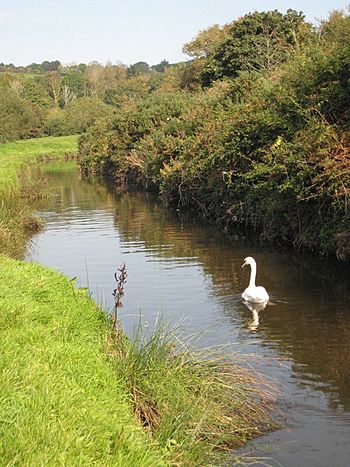River Cober facts for kids
Quick facts for kids River Cober |
|
|---|---|

The Cober near Helston
|
|
| Native name | Dowr Kohar |
| Country | United Kingdom |
| Region | Cornwall |
| Physical characteristics | |
| Main source | Nine Maidens Downs |
| River mouth | Loe Pool Mount's Bay |
The River Cober (which in Cornish is called Cornish: Dowr Kohar) is a short river in west Cornwall, England, United Kingdom. The river flows west of Helston and empties into Loe Pool, which is the biggest natural lake in Cornwall.
Contents
River Cober's Journey
The River Cober begins its journey in a place called Nine Maidens Downs. This area is between Hangman's Barrow and the Nine Maidens stone circle. The river then flows to the west of the town of Helston. After passing Helston, it enters Loe Pool, which is the largest natural lake in Cornwall.
Loe Pool and Loe Bar
The water in Loe Pool is held back by a natural barrier called Loe Bar. This bar is made of sand and shingle. Even though the river ends at Loe Pool, its path can be traced several kilometers further out into Mount's Bay.
Mining History Near the River
For over a hundred years, there was a lot of mining activity in the area around the River Cober. This mining stopped in 1938. You can still see the old engine house of Castle Wary (also known as Wheal Pool) near Nansloe, on the east side of the river below Helston. This shows how important mining was in the past.
Changes to the River
In 1946, the lower parts of the river were straightened and made deeper, a process called canalisation. Later, in 1987, a raised road or path, known as a causeway, was built over Loe Marsh.
What Does "Cober" Mean?
The exact meaning of the name "Cober" is not fully clear. Some old records from the 1200s call it "Chohor" or "Dowr Coghar," which means "scarlet river." This name likely came from the color of the water due to waste from mining. However, about 400 years ago, the river was known as the "River Loe" or "River Looe."
How Loe Bar Was Formed
For a long time, people believed that the River Cober used to flow directly into the sea until the 1200s. They thought that sand then blocked its mouth, creating Loe Bar and Loe Pool.
Sea Level Rise and Sediment
However, scientists now think that Loe Bar was most likely formed by the sea level rising after the last ice age. As the sea level went up, it pushed a lot of sand and other small rocks into the river's mouth. This created a natural barrier, like a beach, that blocked the river.
Flint in Loe Bar
Interestingly, Loe Bar is mostly made of a type of rock called flint. Flint is not usually found in Cornwall. The closest place on land where flint is common is about 120 miles (190 km) away in east Devon. The most likely place this flint came from is offshore. There were once ancient river terraces, now underwater, that flowed between England and France, under what is now the English Channel.
Local History and the River
In the 1870s, people tried to find and dig up china clay on Porkellis Moor. They spent a lot of money and built some structures, but by 1879, they sold everything, and by 1884, the works were abandoned.
The Helston Railway
The Helston branch railway used to run along part of the River Cober valley into Helston. This railway line, which closed in 1962, crossed the main river on a large bridge called the Cober Viaduct. This viaduct has five arches.

